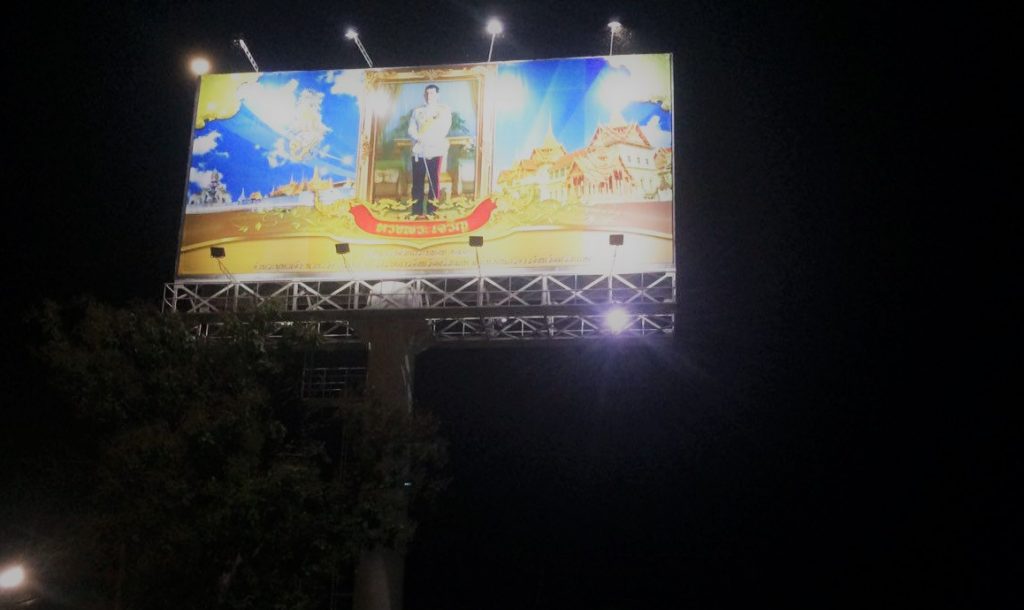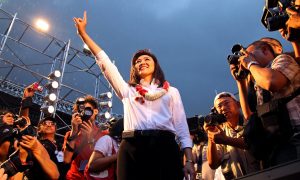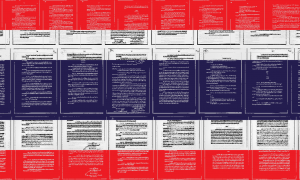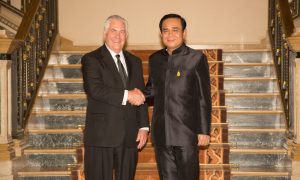The highlight of my recent visit to Phra That Phanom, the holiest Buddhist site in Northeastern Thailand, was my encounter with a life size cutout of King Vajiralongkorn on his bicycle.
I’ve never seen a life size figure of King Vajiralongkorn like this one before. How are passers-by supposed to interact with it? Surely the city officials, or whoever put the figure there, don’t really expect pedestrians to kneel down and place offerings in front of the bike? Why is a life size cutout of the new king thinkable, when it would be unthinkable to have one of the late King Bhumibol?
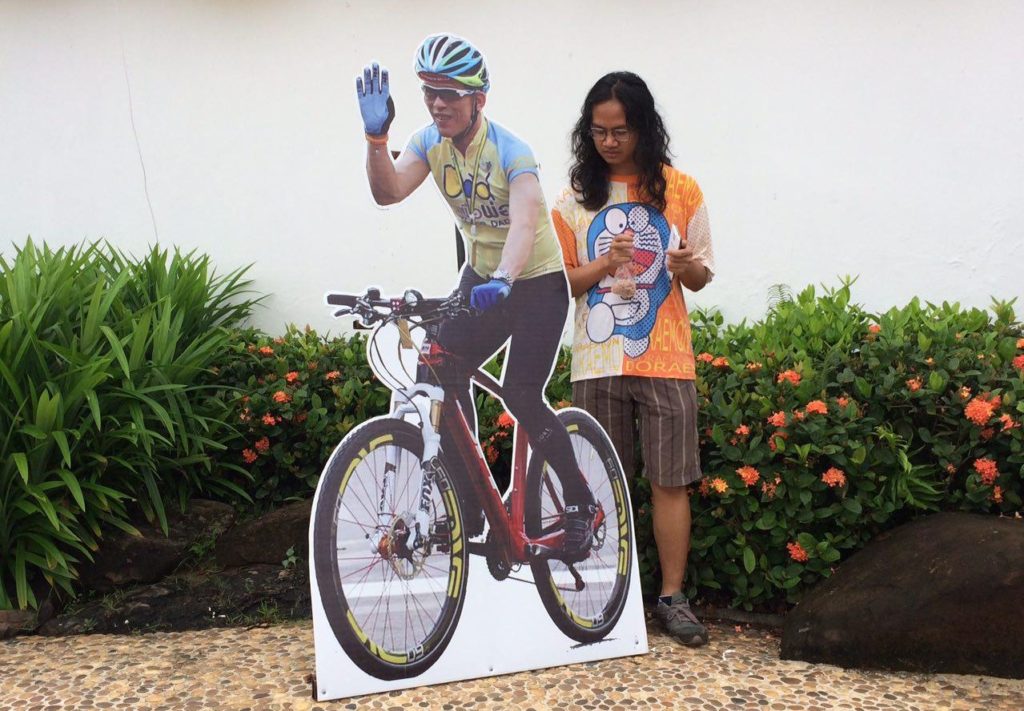
And why is it there, right by the walls of the Phra That Phanom temple, where the putative breastbone of the Buddha lies? Is this the adaptation of the Thai monarchy to today’s era where everyone is the media, and citizens have been convicted for committing lese majeste on social media? Is this cutout of King Vajiralongkorn waiting for people to snap a shot, comment and share? Can I pose with it?
This life size figure is my starting point for thinking about a different logic of royal image-making, and how it might compare and contrast with older ways of representing the kingly body.
Geo-body
In a recent essay, anthropologist Andrew Alan Johnson writes about a particular sacred being in Isaan who refused King Bhumibol entry in the 1950s.
Johnson refers to the evolution of monarchies from premodern to modern times. In premodern times, royal centres competed for power through their spheres of influence, which emanated from the court. But in modern times, monarchies adapt to become one with the nation-state, their territory carved out along the national “geo-body” arising out of modern maps.
In Siam/Thailand, this transition wouldn’t be complete until the reign of King Bhumibol, when the mass circulation of the King’s photos ensured his presence everywhere. The coming of these photos coincided with King Bhumibol’s travels to faraway provinces around the turn of the Buddhist century (in the mid-1950s).
There was one province, however, that King Bhumibol never set foot in. And that’s Mukdahan, whose local royal spirit chao fa mung mueang pre-empted the entry of another royal. (Granted, at that time Mukdahan was not its own province; it was still part of Nakhon Phanom Province.)
Johnson points out that this local deity’s sovereignty has taken the modern “geo-body” form, his rule a singular one over the geographically demarcated city.
The images of the late king’s visit have become the glue that binds every faraway province in the modern Thai nation together. In my hometown of Sisaket, one can see black and white images of the king and queen’s visit in November 1955, blown up big and plastered around the walls in a permanent exhibition by the municipality.
King Bhumibol’s images during his visits to “the provinces” have always been cast as evidence of his down to earth conduct, one that erases all distance between the monarch and his lowliest, most faraway subjects.
This presentation of closeness, however, doesn’t necessarily mean the king himself becomes more accessible. Anthropologist Rosalind C. Morris writes in her 1998 essay Surviving Pleasure at the Periphery:
Indeed, the era of mass media in Thailand corresponds directly to that of a new monarchical visibility. Where once the king’s power entailed his secrecy, his withdrawal from commoners’ eyes, he is now the most visible of all Thai citizens, and indeed he is often pictured on his walking tours of the nation with a camera around his neck. However, the photographic circulation of the king should not be confused with a simple coming into immediate sight, or a pure revelation. He is no more immediately accessible to “the people” now than he was a hundred years ago, when commoners could only approach his dignified body from the perspective of his foot’s sole.
Morris’s description of apparent visibility and actual inaccessibility is apt for the current monarch as well. Even as King Rama X’s portraits appear everywhere, the king rarely appears in nightly palace news. His actual activities in Thailand and overseas remain public secrets.
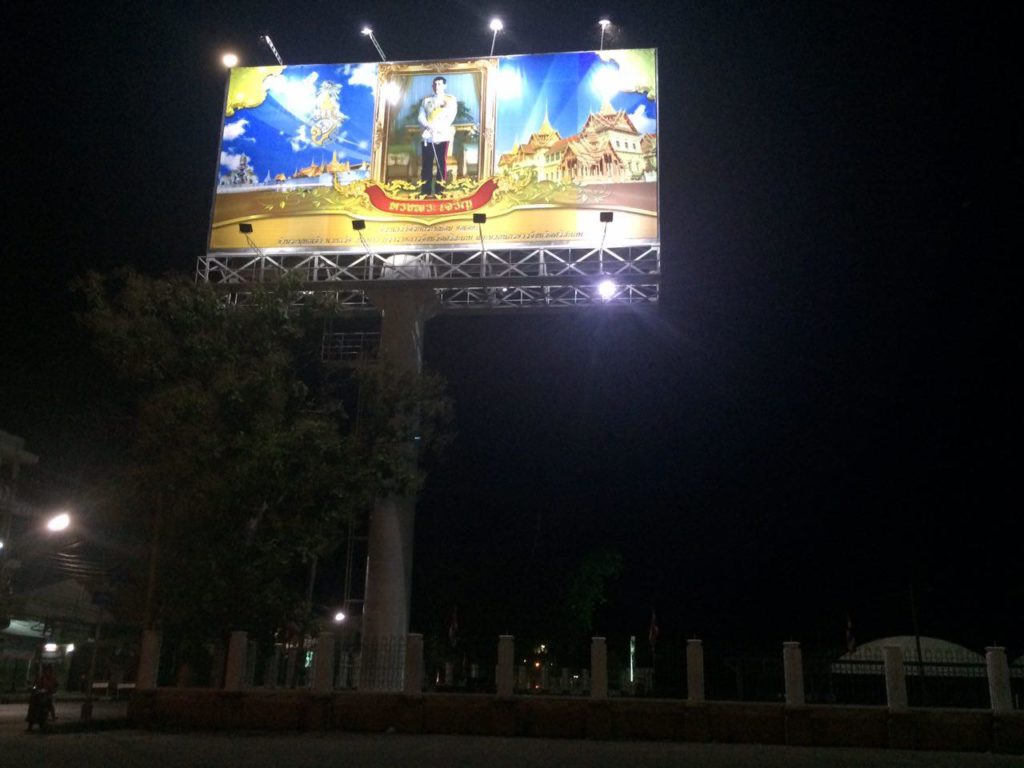
A billboard featuring King Rama X within a golden frame at Sisaket City Hall. (Photo: author)
To encounter the eye-catching figure of King Vajiralongkorn on a bike is therefore a surprise that demands analysis.
Father and son
In Singapore, it is a fact that the country’s late patriarch Lee Kuan Yew and his eldest son, Prime Minister Lee Hsien Loong, rarely appeared side by side in any official capacity. The two’s co-presence would presumably be unstrategic, their auras competing with one other.
Yet in Thailand, the auras of Vajiralongkorn and Bhumibol were eminently compatible (or transferable?), as seen in the lead up to 2015’s “Bike for Dad” mega-event.
During that time, billboards all over Thailand advertised the upcoming cycling event through various photographs of Bhumibol and Vajiralongkorn, and only of these two—the palpable absence of Bhumibol’s three other children from all of it was almost uncomfortable.
It was one of the rare occasions where Vajiralongkorn, and not anyone else, was placed at the charismatic centre of a national spectacle. And it was the moment when the image of Vajiralongkorn on the plastic cutout was captured.
I’m still not used to calling Vajiralongkorn king. Often I lapse back to “the crown prince”. Indeed, in the photograph used for the cutout he was the crown prince, headlining the cycling event to show the world his devotion to his father, who was/is also the Father of the Nation.
The event’s logo puts the royal cyphers of the father and the son side by side, the former much bigger and more saturated in colour. Together, the two cyphers look like a penny-farthing where the front wheel has a much bigger diameter than the rear wheel.
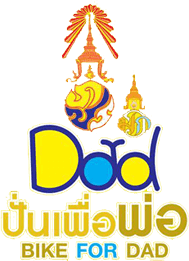
Now, the “crown prince” royal cypher in the logo [left] is no longer in use. Vajiralongkorn’s cypher as king has become very similar to the previous king’s, retaining the same style for the crown, the halo, and the character design underneath, only changing out the Thai number ๙ “IX” for ๑๐ “X”, and the letter ภ “Bh” for ว “V”.
It is reasonable to speculate that the life size cutout of Vajiralongkorn was produced during or shortly after the “Bike for Dad” event so as to create an effect of “being there” among participants in the national margins like Nakhon Phanom. Having the figure of the faraway future King right in the central public space of one’s town probably makes it feel like one’s participation at the national periphery wasn’t really that peripheral, after all.
The photograph used gives off a very different feeling from the iconic image of King Bhumibol bending down to touch the raised palms of the elderly woman subject. Rather than closeness, I would even go further to say that the “Bike for Dad” royal images put forward an idea of equality, that the future king bikes for the same dad and wears the same shirt as other Thai citizens participating in the event. “Bike for Dad” even had concurrent events worldwide organised by Thailand’s embassies and consulates.
The “geo-body” and the “gym body”
The idea behind King Rama X’s life size figure on a bicycle doesn’t quite match up with either the premodern “sphere of influence” model or the modern “geo-body” model.
From his form-fitting clothing, one can see the size of the 63-year-old Prince’s calves and the definition of his triceps. Is it criminal to admire his gym body? Apparently not. Around the time of the “Bike for Dad” event, comments surged in social media about how Vajiralongkorn was, in royal-speak, “song phra fit and firm very much!”
One may recall the young King Bhumibol sailing in the 1967 Southeast Asian Peninsular Games in Pattaya, representing his own brand of athleticism and worldliness (here’s a New Englander!) back in the day. I remember watching a video about Lee Kuan Yew’s physical strength in his old age. He kept swimming every day in his personal pool! Perhaps this show of physical fitness is a technology of power, showing how the head of state keeps his body fit, a sign of his self-discipline and physical attractiveness.
So instead of a king ruling a national “geo-body” from his ubiquitous framed portraits, we have here a “gym body” whose symbolic power doesn’t directly shore up the sanctity and the integrity of the modern monarchy. Rather, its power extends erratically, and through desire—of his physical body and the underlying self-discipline that it implies. Royal virtue becomes visible in the form of the body, and we subjects are allowed to admire it for our own sake.
As public criticism of the royal family isn’t possible, quasi-sexual admiration sure does relieve some of the pressure permeating the public silence enforced by the rule of fear. If you can’t publicly speculate about the state of his health, you sure can talk about his “fit and firm” body!
But one question remains. If this photograph suggests not only closeness but equality, one which no longer relies on the concept of the royal family as inherently sacred, then how do we know where the line of sacrilege is?
Images (royal or otherwise) to be paid respect to in Thailand are typically made out of more “spectacular” materials: bronze for statues, or sparkly and colourful pieces of cloth wound around sacred trees, to give a few examples. Or, in the case of printed vinyl signs, such as the above billboard in Sisaket City, the image of the king is surrounded in a golden frame, the spires of Bangkok temples, and well-lit spotlights: everything is appropriately royal.
But the corrugated plastic “Bike for Dad” figure of Vajiralongkorn stands frameless next to some bushes. Lacking any frame, this image of the king can’t be a fitting representation of the sovereign, let alone a sacred object. The closest comparison to this can be seen in convenience stores, where a life size cut out of a celebrity selling some beverage or cosmetics greets you with a smile. The king’s “gym body” attests to a different mode of power, even as it coexists with the efforts to sustain the old royal frame.
Invisible body
Since the death of King Bhumibol last October, devoted subjects have been flocking to pay respects to his body in Bangkok. This ritual isn’t about actually seeing the body with one’s own eyes, unlike the case of Ho Chi Minh’s eternal body in his mausoleum, but rather about the prospects of “meeting” the King for the last time—the physical body remains out of reach, yet one can come in contact with his ideal body.
Notably, the logic here reverts back from a modern monarch whose power is secured by photographic omnipresence to a secret, singular body whose power emanates from its very invisibility.
Within the hall housing the late King Bhumibol’s body, photography is forbidden. Access to his audience is limited only to those who make the personal effort to get there in proper attire; it is not extended to their followers on social media. The few who do share photos from inside the Throne Hall are heavily condemned by others who observed the “no photography” rule.
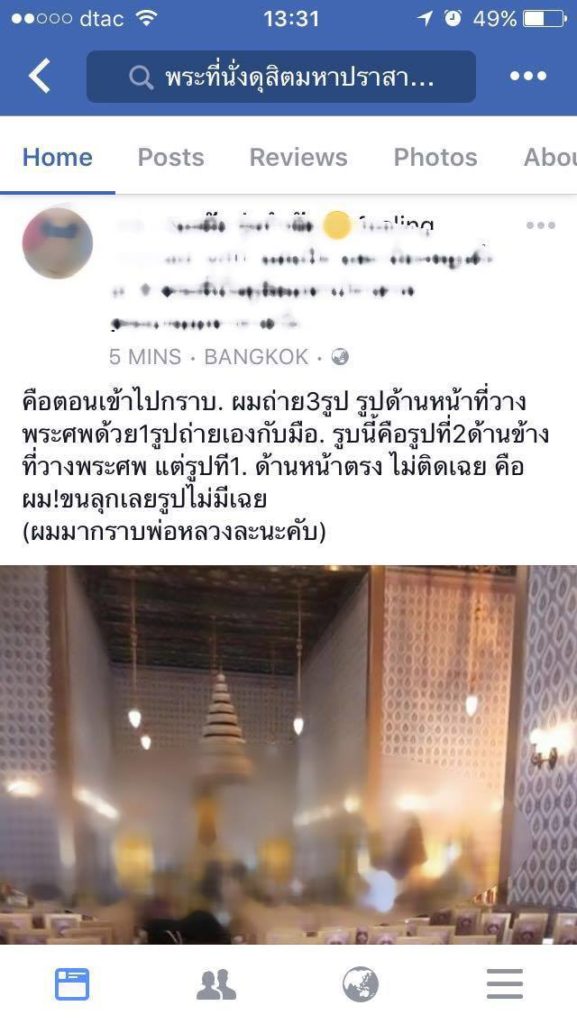
A photograph someone took of the inside of the Dusit Maha Prasat Throne Hall where King Bhumibol’s body is placed. The photo has been blurred by the reposter “lest someone uses it for bad purposes” (Source: http://www.posttoday.com/social/hot/504824)
Interestingly, the original poster of the “inappropriate” photograph above said in the caption that among the three photos he took while inside the hall, he took one right in front of the royal coffin, where worshippers prostrate themselves. Magically, that photo that he took didn’t get stored in his smartphone’s memory. “I got goose bumps—the photograph wasn’t there!”
As indecorous as this person was, he still wasn’t immune to royal magic, which overwrote the record of digital photography.
From my survey of people’s stories of their visits posted online, they see this ritual as an opportunity to “get close” to the late King for the last time (or the first time for some). The many hours of waiting didn’t deter them. On some crowded days visitors had to wait in line for up to 18 hours.
It may be relevant to compare this ritual of paying respects to the royal body to Buddhist pilgrimage. In north-eastern Thailand, it is said that once in a lifetime you should get to pay your respects to the relic of the Buddha at Phra That Phanom. Before the age of modern conveniences, people used to journey there by foot, which could take many days. Once you get there, you don’t really see the putative breastbone of the Buddha, but “being there” is enough for you to be blessed by the meeting with the Buddha’s ideal body.
Going to pay respects to King Bhumibol’s body is likewise cast as a once in a lifetime opportunity, almost a privileged duty, for Thai citizens.
Now is the final week for people to make a pilgrimage to the Throne Hall in Bangkok. The palace has just extended the time for the public to pay their respects to the late King to October 5, and is allowing the public to visit 24 hours a day.
It’s been almost one year since the end of King Bhumibol’s reign, and King Vajiralongkorn is still not officially crowned. Will the upcoming cremation for King Bhumibol this month be the end of an old regime of mass media(tion) reproducing the King’s image, or will it not?
…………………………
Peera Songkünnatham is a writer and translator who lives in Sisaket City, Thailand. Peera can be reached via email at peera[at]isaanrecord[dot]com
 Facebook
Facebook  Twitter
Twitter  Soundcloud
Soundcloud  Youtube
Youtube  Rss
Rss 